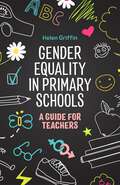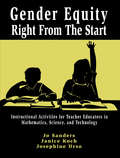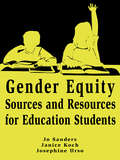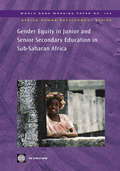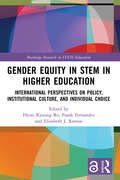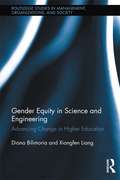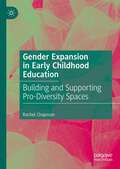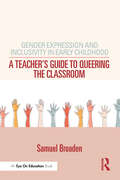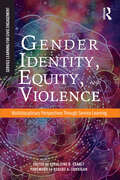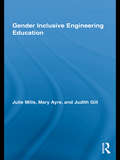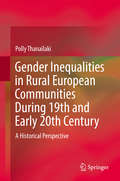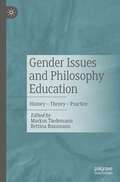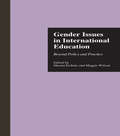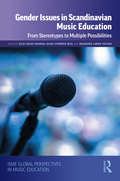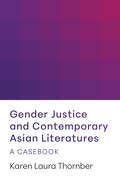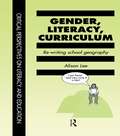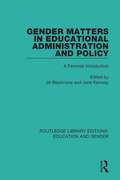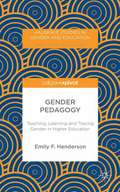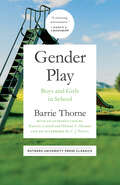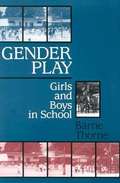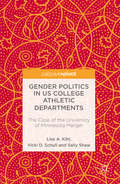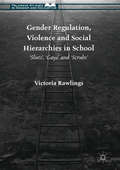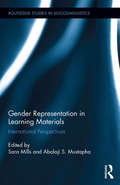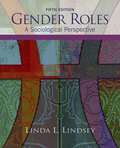- Table View
- List View
Gender Equality in Primary Schools: A Guide for Teachers
by Helen GriffinThis hands-on guide supports primary teachers and other school staff in challenging gender stereotypes, and sets out advice on how to implement gender equality and respect in the curriculum, and in all areas of school life. An increase in the number of transgender children - and a recognition of gender reassignment as a protected characteristic under the 2010 Equality Act - means that all primary schools need to ensure they are safe environments respectful of all genders. This book draws on the 'Gender Respect Project', which identified the need to address gender stereotyping and gender-based violence with children and young people. The book is full of lesson plans, case studies, clear guidance and recommended actions as well as further reading and resources. Extending beyond awareness of other genders, this book provides a framework for a gender equality approach in the classroom, and empowers children to think critically about gender and to respect themselves and others.
Gender Equity Right From the Start
by Jo Sanders Janice Koch Josephine UrsoWhat makes girls avoid math, science, and technology in school? And what can teacher educators do to help new teachers keep this from happening so that all of our children's talents can find expression? These two volumes provide teaching materials and background information on gender equity for teacher educators in mathematics, science, and technology education and their students. A practical guide, Gender Equity Right from the Start is usable by professors of education for preservice teachers and by staff developers for in-service teachers. By adapting the material for other subjects, it can also be used by teacher educators in content areas other than math, science, and technology. It consists of two volumes: Instructional Activities for Teacher Educators in Mathematics, Science, and Technology contains some 200 teaching activities on the major issues in gender equity, emphasizing solutions and not just problems. Activities take place in out-of-class assignments and field experiences whenever possible to minimize demands on class time. Sources and Resources for Education Students in Mathematics, Science, and Technology contains student materials needed for the activities as well as extensive print, electronic, organizational, and other resources for further information.
Gender Equity Sources and Resources for Education Students
by Jo Sanders Janice Koch Josephine UrsoWhat makes girls avoid math, science, and technology in school? And what can teacher educators do to help new teachers keep this from happening so that all of our children's talents can find expression? These two volumes provide teaching materials and background information on gender equity for teacher educators in mathematics, science, and technology education and their students. A practical guide, Gender Equity Right from the Start is usable by professors of education for preservice teachers and by staff developers for in-service teachers. By adapting the material for other subjects, it can also be used by teacher educators in content areas other than math, science, and technology. It consists of two volumes: Instructional Activities for Teacher Educators in Mathematics, Science, and Technology contains some 200 teaching activities on the major issues in gender equity, emphasizing solutions and not just problems. Activities take place in out-of-class assignments and field experiences whenever possible to minimize demands on class time. Sources and Resources for Education Students in Mathematics, Science, and Technology contains student materials needed for the activities as well as extensive print, electronic, organizational, and other resources for further information.
Gender Equity in Junior and Senior Secondary Education in Sub-Saharan Africa
by World BankThis thematic study consists of case studies of Ghana, Malawi, and Uganda, as well as, a review of studies undertaken over the past ten years on education in Africa with particular attention to girls' and secondary education. Gender equity at the primary level has been the focus of considerable attention within the Education for All Framework of Action, but much less so at the secondary level. Evidence of gender inequity and inequality in terms of access, retention and performance in secondary education in SSA raises many questions. While transition rates from primary to secondary are higher for girls than boys, and the repetition rates are lower, girls still significantly trail behind boys in graduation and enrollment rates. The purpose of this study is to document and analyze the extent and nature of gender disadvantage in junior and senior secondary education, to analyze the causes of this disadvantage, and to identify strategies that may be effective in reducing or eliminating it. This study was prepared as part of the Secondary Education and Training in Africa (SEIA) initiative which aims to assist countries to develop sustainable strategies for expansion and quality improvements in secondary education and training. All SEIA products are available on its website: www.worldbank.org/afr/seia.
Gender Equity in STEM in Higher Education: International Perspectives on Policy, Institutional Culture, and Individual Choice (Routledge Research in STEM Education)
by Hyun Kyoung RoThis timely volume brings together a range of international scholars to analyse cultural, political, and individual factors which contribute to the continued global issue of female underrepresentation in STEM study and careers. Offering a comparative approach to examining gender equity in STEM fields across countries including the UK, Germany, the United States, Hong Kong, Taiwan, South Africa, and China, the volume provides a thematic breakdown of institutional trends and national policies that have successfully improved gender equity in STEM at institutions of higher education. Offering case studies that demonstrate how policies interact with changing social and cultural norms, and impact women’s choices and experiences in relation to the uptake and continuation of STEM study at the undergraduate level, the volume highlights new directions for research and policy to promote gender equity in STEM at school, university, and career levels. Contributing to the United Nations’ (UN) 2030 Agenda for Sustainable Development, this text will benefit researchers, academics, and educators with an interest in science education, higher education, and gender equity in STEM fields. The text will also support further discussion and reflection around multicultural education, educational policy and politics, and the sociology of education more broadly.
Gender Equity in Science and Engineering: Advancing Change in Higher Education (Routledge Studies in Management, Organizations and Society)
by Diana Bilimoria Xiangfen LiangWomen faculty’s participation in academic science and engineering is critical for future US global competitiveness, yet their underrepresentation particularly in senior positions remains a widespread problem. To overcome persistent institutional resistance and barriers to change, the NSF ADVANCE institutional transformation initiative, instituted in 2001, seeks to increase the workforce participation of women faculty in academic science and engineering through systematic institutional transformation. This book assesses the equity, diversity and inclusion outcomes of the changes underway at 19 universities. It provides a comprehensive, stand-alone description of successful approaches to increase the recruitment, advancement and retention of women faculty throughout the academic career pipeline. The findings show that targeted institutional transformation at these 19 U.S. universities has resulted in significant increases in women faculty’s workforce participation, as well as improved gender equity and inclusion. Analyses by discipline show that the greatest changes have occurred within engineering and natural science disciplines at these universities. Yet the results also point to the overall continued underrepresentation of women faculty in academic science and engineering at the nation’s research universities. A framework of organizational change is derived to serve as a template to academic and other organizations seeking transformation to enhance gender equity, diversity and inclusion.
Gender Expansion in Early Childhood Education: Building and Supporting Pro-Diversity Spaces
by Rachel ChapmanThis book explores the contexts for gender identity development in early childhood education, examining how early childhood educators’ views on children’s gender identity influence their practice in Australia. The author utilizes feminist post-structuralism, queer theory and performativity as theoretical approaches, and feminist post-structuralist discourse and thematic analyses. The book captures the voices of educators and developers of curriculum documents to explore how gender expansive environments can be created when such environments are socially and politically contentious. It then identifies discourses that enable and constrain the building of pro-diversity spaces and contexts in early childhood education, while considering how to disrupt normative notions of gender and promote the deployment of discursive agency.
Gender Expression and Inclusivity in Early Childhood: A Teacher's Guide to Queering the Classroom
by Samuel BroadenThis important and engaging guide details best practices for supporting the exploration and expression of gender in early years contexts. It explains how to use self-reflection, community collaboration, and action plans to create supportive environments and equitable opportunities for queer children and teachers in early years classrooms and schools. Featuring real-life examples from current classroom practice, the book includes diverse voices of children and adults alike, providing new ways for readers to connect to historically undervalued ideas of inclusion and expansiveness around emerging identities and personal power. Providing clear, practical recommendations in an accessible and engaging way, Gender Expression and Inclusivity in Early Childhood is an essential read for any teacher or school leader who wants to create kinder, more supportive, gender diverse environments for all children and educators.
Gender Identity, Equity, and Violence: Multidisciplinary Perspectives Through Service Learning
by Robert A. Corrigan Geraldine B. StahlyThe authors of the thirteen chapters in this volume bring excitement and innovations to teaching about gender from a wide range of theoretical and discipline perspectives. They exhibit the inclusiveness that is central to feminist pedagogy–a perspective that centers the educational enterprise in the analysis of the interconnectedness of social categories that have traditionally divided and given root to inequality and oppression and aims for no less than social transformation. Empowerment is a core value in gender education and the experiential approach nurtures that goal. This volume provides many examples of the power of learning through experience as the authors demonstrate that, “…the authority of the feminist teacher as intellectual and theorist finds expression in the goal of making students themselves theorists of their own lives by interrogating and analyzing their own experience.” (Weiler, 1991)To stimulate the adaptation of the approaches described in these books, each volume includes an Activity / Methodology table that summarizes key elements of each example, such as class size, pedagogy, and other disciplinary applications.
Gender Inclusive Engineering Education (Routledge Research in Education)
by Judith Gill Julie Mills Mary Elizabeth AyreWomen continue to comprise a small minority of students in engineering education and subsequent employment, despite the numerous initiatives over the past 25 years to attract and retain more women in engineering. This book demonstrates the ways in which traditional engineering education has not attracted, supported or retained female students and identifies the issues needing to be addressed in changing engineering education to become more gender inclusive. This innovative and much-needed work also addresses how faculty can incorporate inclusive curriculum within their courses and programs, and provides a range of exemplars of good practice in gender inclusive engineering education that will be immediately useful to faculty who teach engineering students.
Gender Inequalities in Rural European Communities During 19th and Early 20th Century: A Historical Perspective
by Polly ThanailakiThis book provides an overview of women’s opportunities for schooling, their social activities, and the social biases they faced in rural communities in Greece, Italy and parts of the Balkans during the 19th and early 20th century. It examines such topics as female illiteracy, the efforts of women-protestant missionaries to expand knowledge through Protestantism, the prejudice against education for women, the socio-economic context, the roles women fulfilled, and the structure of the patriarchal family. The book approaches these issues from the perspective of pedagogy and social history. The fundamental questions discussed by the book are: How was female education viewed by the country folk? What was the role of women in the private and the public sphere? How did peasant women respond to the challenges of the ‘modern’ world? Were they free to express their feelings and ambitions? In what way? Were they happy?
Gender Issues and Philosophy Education: History – Theory – Practice
by Markus Tiedemann Bettina BussmannWith this volume a gap in the philosophical didactics is closed. A historical section initially introduces authors who have determined the gender discourse and at the same time a critical discussion. This is followed by an overview of sexual and gender diversity, its basics and differentiations. Theoretical papers then deal with the relevance of gender research for the self-understanding of philosophical education. Finally, practice-specific contributions demonstrate how topics and aspects of the gender problem can be prepared for different age groups and school types. With 2 lesson plans.
Gender Issues in International Education: Beyond Policy and Practice (Reference Books in International Education)
by Maggie Wilson Sheena ErskineFirst Published in 1999. Routledge is an imprint of Taylor & Francis, an informa company.
Gender Issues in Scandinavian Music Education: From Stereotypes to Multiple Possibilities (ISME Series in Music Education)
by Silje Valde OnsrudGender Issues in Scandinavian Music Education: From Stereotypes to Multiple Possibilities introduces much-needed updates to research and teaching philosophies that envision new ways of considering gender diversity in music education. This volume of essays by Scandinavian contributors looks beyond the dominant Anglo-American lens while confronting a universal need to resist and rethink the gender stereotypes that limit a young person’s musical development. Addressing issues at all levels of music education—from primary and secondary schools to conservatories and universities— topics discussed include: the intersection of social class, sexual orientation, and teachers’ beliefs; gender performance in the music classroom and its effects on genre and instrument choice; hierarchical inequalities reinforced by power and prestige structures; strategies to fulfill curricular aims for equality and justice that meet the diversity of the classroom; and much more! Representing a commitment to developing new practices in music education that subvert gender norms and challenge heteronormativity, Gender Issues in Scandinavian Music Education fills a growing need to broaden the scope of how gender and equality are situated in music education—in Scandinavia and beyond.
Gender Justice and Contemporary Asian Literatures: A Casebook
by Karen Laura ThornberThis casebook investigates how diverse writers from across East, South, and Southeast Asia and their diasporas have engaged with the struggle for gender justice. Each chapter analyzes works of literature originally written in Bengali, Chinese, English, Indonesian, Japanese, Khmer, Korean, Marathi, Thai, and Vietnamese.Aimed at both specialists and nonspecialists, Gender Justice and Contemporary Asian Literatures addresses such subjects as gender imparity in male-dominated professions; the lives of migrant sex workers and caregivers; the fight against reproductive, family, non-partner, and intimate partner violence; and norms of shame and silence surrounding violence against women. Informed by the author's deep knowledge of literature, history, culture, law, and social conditions, this book will be a resource for instructors and students in gender studies, women's studies, ethnic studies, Asian studies, Asian American studies, Asian diaspora studies, comparative literature, and world literature.
Gender Literacy & Curriculum: Rewriting School Geography (Critical Perspectives On Literacy And Education Ser.)
by Alison LeeFirst Published in 1996. Routledge is an imprint of Taylor & Francis, an informa company.
Gender Matters in Educational Administration and Policy: A Feminist Introduction (Routledge Library Editions: Education and Gender #1)
by Jane Kenway Jill BlackmoreOriginally published in 1993. This introductory text brings the somewhat gender blind fields of educational administration and policy into contact with feminism. The chapters here demonstrate the considerable scope and potential of feminist scholarship for the field with regard to theory, research and practice and open up new possibilities for effecting gender justice in and through education. The first part looks at educational history, the second at contemporary issues like assessment, ethical practices, equal opportunities and parental participation, and the third at political and administrative theory.
Gender Pedagogy: Teaching, Learning and Tracing Gender in Higher Education
by Emily F. HendersonWhen addressed in its full reactive potential, gender has a tendency to unfix the reassuring certainties of education and academia. Gender pedagogy unfolds as an account of teaching gender learning that is rooted in Derrida's concept of the 'trace', reflecting the unfixing properties of gender and even shaking up academic knowledge production.
Gender Play: Boys and Girls in School (Suny Series On Sport, Culture, And Social Relations Ser.)
by Barrie ThorneWhen it first appeared in 1993, Barrie Thorne’s Gender Play: Girls and Boys in School became an instant classic in the budding fields of feminist sociology and childhood studies. Through detailed first-hand observations of fourth and fifth graders at play, she investigated questions like: Why do girls and boys tend to self-segregate in the schoolyard? What can playful teasing and ritualized games like “cooties” and “chase and kiss” teach us about how children perform gendered identities? And how do children articulate their own conceptions of gender, distinct from those proscribed by the adult world? A detailed and perceptive ethnography told with compassion and humor, Gender Play immerses readers in the everyday lives of a group of working-class children to examine the social interactions that shape their gender identities. This new Rutgers Classic edition of Gender Play contains an introduction from leading sociologists of gender Michael A. Messner and Raewyn Connell that places Thorne’s innovative research in historical context. It also includes a new afterword by one of Thorne’s own students, acclaimed sociologist C.J. Pascoe, reflecting on both the lasting influence of Thorne’s work and the ways that American children’s understandings of gender have shifted in the past thirty years.
Gender Play: Girls and Boys in School
by Barrie ThorneThorne, a professor of sociology at the University of Southern California, offers her insightful observations of elementary school students in class and at play. Though, as she admits, her status as an adult and an observer may have affected what happened around her, Thorne presents a fascinating account of how children divide themselves--and how others divide them--along gender lines. Breaking students into teams for contests and the eternal game of "cooties" (a contamination attributed more often to girls than boys) reveal much about the microcosm that these students inhabit, and an extensive look at the tomboy, both in literature and in life, compares her ambiguity (sometimes an insult, sometimes a compliment) to the negative attitudes often elicited by gender-crossing in the other direction. Thorne argues convincingly against the theories of scholars like Deborah Tannen and Carol Gilligan that boys and girls have different "cultures," and she attempts to discourage "gender antagonism." A final section offers concrete steps for teachers to take in forming the attitudes--about gender and other topics--of coming generations.
Gender Politics in US College Athletic Departments
by Lisa A. Kihl Vicki D. Schull Sally ShawThis book examines the gendered politics in the context of a merger of the women's and men's athletic departments at the University of Minnesota over a ten year plus span. Examining the athletic department merger helps us understand women's continual under-representation in University athletics despite Title IX legislation passing 40 years ago. Using interview with organizational stakeholders and archival document data, the book explores how organizational change in the form of a merger is gendered with relation to the premerger, merged, post-merger stages.
Gender Regulation, Violence and Social Hierarchies in School
by Victoria RawlingsThis book investigates the reasons why the traditional psychological understanding of bullying fails those affected, and deconstructs how bullying is shaped by prominent discourse. By drawing on poststructuralist feminist theory Victoria Rawlings highlights the social and cultural inequalities too often forgotten in analysis of aggressive behaviour in schools, and places particular emphasis on gender and sexuality as facilitating and constraining forces within school environments and bullying discourses. This book provides a necessary assessment as to why current anti-bullying approaches are failing, and offers an alternative explanation as to how and why bullying occurs. This is a timely and authoritative study which is based on qualitative research, including interviews and group sessions which are used to emphasize the real-life experiences of young people in schools today. Interdisciplinary in nature, this book has a broad appeal and will be of special interest to scholars in the fields of gender and sexuality studies, sociology, and education.
Gender Representation in Learning Materials: International Perspectives (Routledge Studies in Sociolinguistics)
by Sara Mills Abolaji S. MustaphaRepresentations of gender in learning materials convey an implicit message to students about attitudes towards culturally appropriate gender roles for women and men. This collection takes a linguistic approach to exploring theories about gender representation within the sphere of education and textbooks, and their effects on readers and students within an international context. In the opening section, contributors discuss theories of representation and effect, challenging the conventional Althusserian model of interpellation, and acknowledging the challenges of applying Western feminist models within an international context. Following chapters provide detailed analyses focusing on a number of different countries: Australia, Japan, Brazil, Finland, Russia, Hong Kong, Nigeria, Germany, Qatar, Tanzania, and Poland. Through linguistic analysis of vocabulary associated with women and men, content analysis of what women and men say in textbooks, and discourse analysis of the types of linguistic moves associated with women and men, contributors evaluate the extent to which gendered representations in textbooks perpetuate stereotypical gender roles, what the impact may be on learners, and the ways that both teachers and learners interact and engage with these texts.
Gender Roles: A Sociological Perspective
by John Mcmanama Linda L. LindseyFor mid-to-upper level courses in Gender Roles, Introduction to Women's Studies, and Sociology of Sex Roles. This text provides a balanced, non-polarized view of controversial issues that dispel gender myths and demonstrates how material can be meaningfully applied to a student's personal life. Focusing on the most recent research and theory--both in the U. S. and globally--Gender Roles provides an in-depth, survey and analysis of modern gender roles and issues from a sociological perspective while also integrating insights and research from other disciplines like biology, psychology, anthropology and history.
Gender School Society And Inclusive School
by K. ThiyaguGender is a social construct that impacts attitudes, roles, responsibilities and behavior patterns of boys and girls, men and women in all societies. Increasing attention has been given to the importance of achieving gender equality in education.
